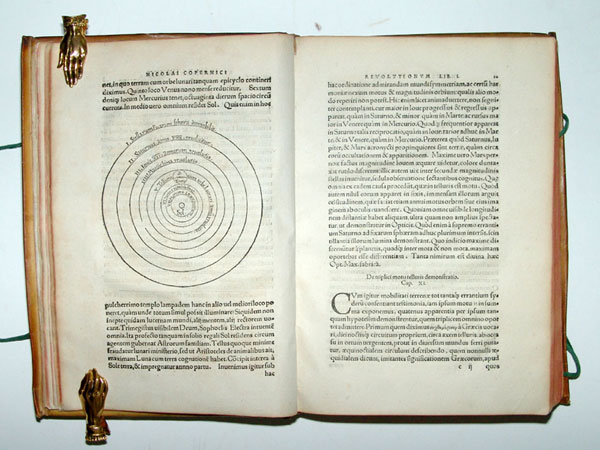Rare Copernicus Book Added to Special Collections at Wellesley College
It’s a Gift To Honor Wellesley’s First Scientist President
| For
immediate release: May 12, 2008 |
Contact:
Arlie Corday, acorday@wellesley.edu |
WELLESLEY, Mass. – Nicolai Copernicus’ book, De Revolutionibus Orbium Coelestium (On the Revolutions of the Celestial Spheres), transformed scientific thinking, showing that the Earth is not the center of the universe. Originally published in 1543, this breakthrough in human thought spawned the study of modern astronomy and the scientific revolution. This week, a rare and valuable second edition of the book was presented to newly inaugurated H. Kim Bottomly during her installation as the 13th president of Wellesley College.
 |
A HELIOCENTRIC VIEW: Copernicus revealed that the sun was the center of our corner of the universe, not the Earth, as shown in this diagram in the open copy of his book, De Revolutionibus Orbium Coelestium, above. Now the rare tome is part of Wellesley's Special Collections, a gift in honor of newly inaugurated President H. Kim Bottomly. |
Appropriately, this cornerstone of science has been given in honor of the college’s first president from the world of science. Bottomly is a renowned immunobiologist who has pioneered studies on cellular changes associated with allergic and asthmatic responses.
For Ruth Rogers, Wellesley’s Special Collections librarian, the book is also the third jewel in the crown. Made possible by a generous gift from Nan Walsh Schow '54 and Howard B. Schow, the Astronomy Department and the Clapp Library, the Copernicus book joins first editions of Darwin’s The Origin of Species and Newton’s Principia, two other masterpieces of science in Wellesley’s collection.
“Wellesley now has the three books generally considered to be the most important works in the history of science,” Rogers said.
In his book, Copernicus revealed for the first time that the Earth and the other planets circle the sun. When it was published, it challenged the authorities of antiquity and the church, beginning a new course toward the modern world.
“The Copernicus is a perfect symbol of the importance of exploration and discovery, a fitting honor for the inauguration of a president who is a scientist,” Rogers said.
The book contains 142 geometrical diagrams, woodcuts and tables, included in the text.
“It is written in Latin, the common language of scholars, so that the world community of scientists could read it,” said Rogers.
Like all of the tomes in Wellesley’s Special Collections, the newest acquisition is available to researchers and will be on display in the reading room after inauguration.
“These books don’t just sit here,” Rogers noted. “They are used for classes all the time. About 40 to 50 classes come to Special Collections each year to use the books in the collection. Students are able to see primary sources that they would not usually have access to at a larger institution.”
Rogers is not concerned about others handling this precious new volume. “These books have lasted for hundreds of years. It’s not going to hurt to have clean hands touching them under supervision. Students,” she added, “get entranced.”
Since 1875, Wellesley College has been a leader in providing an excellent liberal arts education for women who will make a difference in the world. Its 500-acre campus near Boston is home to 2,300 undergraduate students from all 50 states and 68 countries.
###
